How a US strategy is helping gang members in Malmö turn their lives around
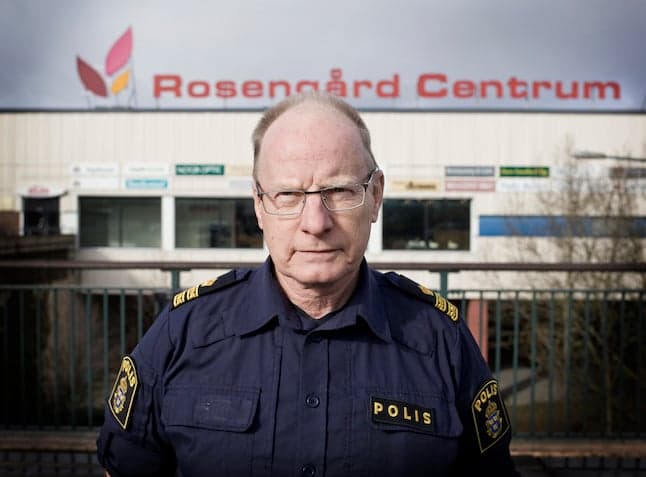
After years of increasingly violent gang crime in Malmö, the southern Swedish city was faced with little choice but to try something new. Here's how police, city officials, organisations and members of the public worked together to sharply reduce the number of shootings.
16-year-old Ahmed Obaid was waiting for the bus in the cold of the winter when he was shot dead on January 12th, 2017, a little before 7pm. He had just started gymnasiet (Swedish upper secondary school) and was a diligent student. He had always wanted to be a pharmacist. Had fled Iraq with his family a few years earlier. Had never been in contact with the police. Was on his way home from sports training and, at that bus stop in the Rosengård district, became one of the first gunshot fatalities in the city of Malmö of that year.
The amount of gang violence in 2017 was unprecedented. An average of five to six shootings took place monthly in Malmö, amounting to 65 shootings in total. Both perpetrators and victims were mainly members of rival drug gangs. The authorities had to find a new solution; they were unable to halt the extreme violence with their usual police and intelligence work.
And where would they know more about gun violence among young adults than in the United States?
The Swedish National Council for Crime Prevention Brå went to New York to meet up with their American counterparts. Professor David Kennedy had developed the so-called Gang Violence Intervention technique, or GVI, which had been adopted in several cities with notorious gang violence since the 1990s. In Boston, the method supposedly resulted in a 63 percent drop in fatal violence among youngsters.
The city of Malmö embraced the strategy as a last resort. They had to do something. One year after they implemented the strategy the number was down to 47 shootings. Another year later: 34. In 2020 the figure was reduced to 20. The GVI strategy, known in Malmö as Sluta Skjut (Stop Shooting), was extended for three years in March 2021, due to its success.
Is that evidence that it works? Yes, says Glen Sjögren, a police officer in Malmö and a coordinator of the GVI strategy in the city. “Of course there are other factors that may contribute. The pandemic has tightened border controls. A significantly larger number of shipments with drugs and weapons are intercepted before they reach Malmö. Some of the most notorious gang members have left for Spain, where they continued their killings. They have been arrested by the Spanish authorities and are facing severe punishments.”
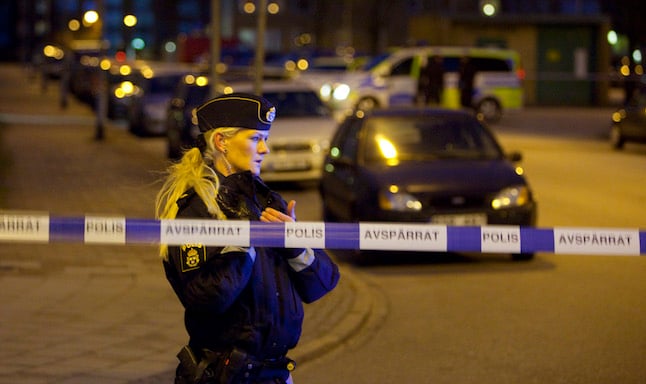
File photo of a police officer in Malmö. Photo: Drago Prvulovic/TT
Sjögren says he is an "old policeman". "I've seen a lot during my career." But he is nothing less than enthusiastic about this approach. The strategy, he believes, makes sense. Everyone is involved: the municipality, the crime prevention council, the police force, the probation service, the social services. Even civil society plays a role.
READ ALSO:
- How Malmö got its gang shootings under control
- Swedish police reveal latest move to crack down on gang crime
- Malmö pushes ahead with US anti-gang method after shootings
The aim, first and foremost, is to contain gun violence. Combating drug trafficking is not an objective of the GVI – a fundamental shift in focus, according to Sjögren. Over the past 30 years, their attention has been mainly on countering the trade in narcotics. Now that is "merely" part of the usual police work. “With the Sluta Skjut team, we emphatically want the killing to stop; for the gang members to lay down their weapons. Everything else is secondary to that end.”
At the start of the process, all members of the different gangs had to be on the team’s radar. “We spoke to just about every policeman and officer in Malmö. We wanted to know very precisely: what person is in which gang, what is their position within the group? It’s the police patrolling the streets who are often best informed.”
The strategy’s poster child is the "call-in": "a bit of a show", according to Sjögren, and "very American". It goes something like this: about ten members of different gangs who are all out on parole and under surveillance are urged to come to the football stadium ("everyone loves our football club"). If they don't show up, they risk 15 days in jail.
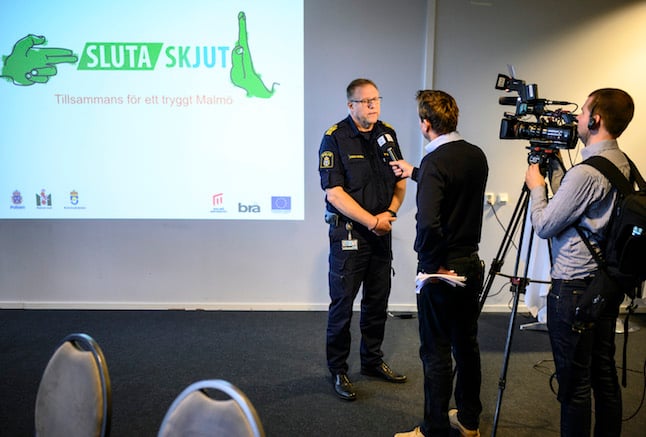
A press conference for Sluta Skjut. Photo: Johan Nilsson/TT
With their probation officer and a police officer they are led into a room with an audience of about 50 people. In the audience they should see familiar – and friendly – faces: "good cops" from their neighbourhoods, community workers. The aim of the audience is to show the boys that the entire society is affected and involved. This informal, social control is one of the founding principles of the GVI.
The boys sit together at a round table. Behind them is the audience. Neither the gang members nor the audience are allowed to talk, ask questions, or laugh. The only thing for them to do is to listen. “This is not a dialogue,” Sjögren emphasises.
Various speakers are then given the podium. They all have five minutes, to the second. The first speakers are a doctor and a nurse who talk about how they operated on a child who had been seriously injured in a traffic accident when a boy came in with a gunshot wound to his chest. What their priorities are at such a moment. How it affects other patients and their families.
After that, politicians from the city council take the stage ("they find it very difficult to speak for just five minutes"), the police commissioner ("same problem"), the chief prosecutor. Next it is Sjögren's turn. “I've been working with criminal youth since 1995 and have known these guys from an early age. That makes it easier to reach them.” Does he never dislike any of these boys? “I have no enemies, only friends, and I have always treated them with respect. That is also the only thing that works.”
The message of these speakers is by and large threefold. One, we don't want you to die. Two, we don't want you to kill anyone. And three: if you want to leave this environment, we will do everything we can to help you.
“We also instill in them that what they do affects the entire group. If one of them detonates a grenade, their social network will be scrutinised; every day, all day. That means that they cannot sell drugs and therefore cannot make money.”
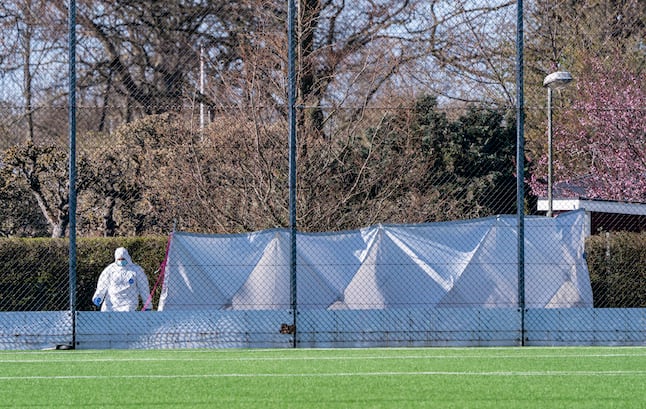
The aftermath of a shooting in Malmö. Photo: Johan Nilsson/TT
It is a central but controversial part of the strategy: to pressure individual gang members, the police are pushing the boundaries of the law. The members of potentially violent gangs are endlessly followed, stopped and questioned. The 30-year-old gang leader of one of the groups had his car searched so many times that he filed a complaint for police harassment.
One of the last speakers at the call-in is a Somali woman who lost her son to a heart defect. He is buried in the same cemetery as many of the gang violence victims. She tells the audience how she sometimes meets these victims’ parents at the graveyard: they come in the evening, out of shame, and then stand there crying in the dark. At this time of the meeting everyone in the room is also crying, Sjögren says, both "clients" and the audience.
After the last speakers (a prison imam and priest) have told their stories, there is fika with pizza, coffee and cookies for everyone in the football club museum. The boys have to go through the crowd to get outside. “We hope they will stop to eat and chat. Some immediately walk to the door, others we nearly have to carry away afterwards.”
Not every gang member has attended one of the call-ins. Only the men with a suspended sentence are summoned. But they then take the message back to their network, Sjögren says.
“Then there is the 'custom notification’, meaning that I and social worker Rebeca Persson go looking for other members wherever they are in the city. We trace them at their home address, on the street, in the hospital or in prison.” These men receive a similar message as delivered at the call-in, but then one on one.
These boys and men know Sjögren, and they listen. "Eighty percent of those guys tell us: ‘We are tired of all the shootings.' They are tired of being scared. Many of them contact Rebeca afterwards.”
115 gang members have received this custom notification. "Over the past year, we regularly heard: ‘We have already read your letter through a friend." Increasingly, calls are coming into the police station from guys asking if they can speak to someone from Sluta Skjut because they want to quit crime. Sjögren tells me he also receives calls from prison: "Can you help me start over once I am released?"
The phone number the boys receive during the call-ins and the home visits is that of the aforementioned Rebeca Persson. She is the GVI coordinator on the side of Konsultationsteamet, a social organisation helping people in Malmö leave the criminal world.
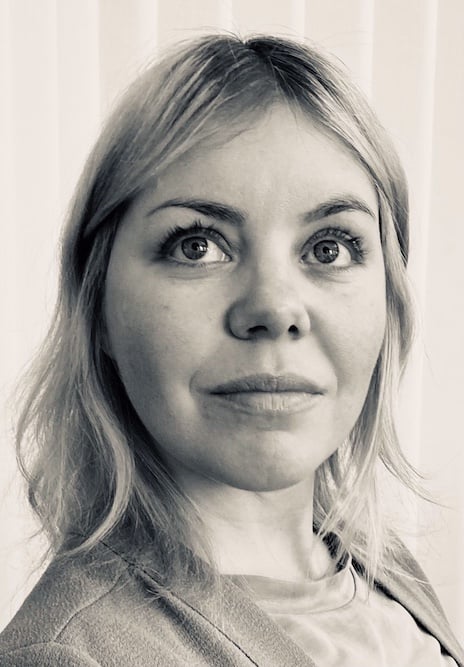
Rebeca Persson. Photo: Private
The boys in the GVI programme are given priority. “We know who belong to the most violent groups. If one of them contacts us, we have to be there for them. The threshold for seeking help should be as low as possible. We can never give guarantees, but such a boy should at least feel that he is being heard and that we are doing everything in our power to help him.”
She's not trying to convince anyone, Persson says. Change must come from within. But she also knows from experience that, sooner or later, those young men will no longer see the benefits of their gang life. "The money, the feeling of belonging: in the long run that no longer outweighs the fear."
Persson slowly tries to bond with these adolescent men. “A person does not change overnight. When they say, ‘I don’t want to talk’, I respect that. But they get my name and number, and they often call back at a later point in time.”
Sometimes it is enough to help them find an occupation (training, job or internship), to speak to them regularly, to assign them a therapist or social worker, to assist them in creating a new, non-criminal social network.
But if the threat from the gang is high, the ex-members can also choose to start all over again elsewhere. Then the social services help them find a home in another city, a daytime activity, a local social worker.
“Moving to another city is difficult for everyone, but especially if you have lived outside the system for a long time. Before they leave, we meet them about four times and try to determine what support they need. We also talk about identity: who are you in Malmö, and who will you be in that new city? Who are you when your identity no longer relies on having money and power? These men have to develop a whole new persona.”
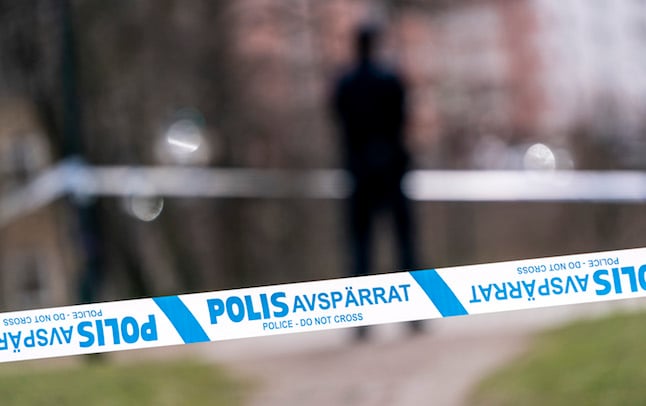
Photo: Johan Nilsson/TT
The desire to be part of society is strong among the majority of these boys, Persson says. “Many of them experience from an early age that they have no access to a normal, Swedish life. But they also say: we simply want an apartment, a job and a family. Just like everybody else. But with the drug money they earn, they cannot even get a telephone plan under their own name.”
Of the 250-300 young men included in the GVI programme, about 40 boys have been imprisoned. In 2019, Persson and her colleagues helped five ex-gang members move and, in one way or another, helped a total of 39 men turn their backs on the criminal milieu. In 2020 Konsultationsteamet moved 14 ex-members and supported 49 of them. “As we get more publicity, we receive more requests."
Persson adds that leaving criminality is not the ultimate objective of Sluta Skjut. “Of course it’s great if these guys want to leave this environment,” she says. “But you cannot expect such a turnaround in everyone. If an entirely new lifestyle is not within reach, then we hope that they’ll at least put down their weapons.”
Comments (1)
See Also
16-year-old Ahmed Obaid was waiting for the bus in the cold of the winter when he was shot dead on January 12th, 2017, a little before 7pm. He had just started gymnasiet (Swedish upper secondary school) and was a diligent student. He had always wanted to be a pharmacist. Had fled Iraq with his family a few years earlier. Had never been in contact with the police. Was on his way home from sports training and, at that bus stop in the Rosengård district, became one of the first gunshot fatalities in the city of Malmö of that year.
The amount of gang violence in 2017 was unprecedented. An average of five to six shootings took place monthly in Malmö, amounting to 65 shootings in total. Both perpetrators and victims were mainly members of rival drug gangs. The authorities had to find a new solution; they were unable to halt the extreme violence with their usual police and intelligence work.
And where would they know more about gun violence among young adults than in the United States?
The Swedish National Council for Crime Prevention Brå went to New York to meet up with their American counterparts. Professor David Kennedy had developed the so-called Gang Violence Intervention technique, or GVI, which had been adopted in several cities with notorious gang violence since the 1990s. In Boston, the method supposedly resulted in a 63 percent drop in fatal violence among youngsters.
The city of Malmö embraced the strategy as a last resort. They had to do something. One year after they implemented the strategy the number was down to 47 shootings. Another year later: 34. In 2020 the figure was reduced to 20. The GVI strategy, known in Malmö as Sluta Skjut (Stop Shooting), was extended for three years in March 2021, due to its success.
Is that evidence that it works? Yes, says Glen Sjögren, a police officer in Malmö and a coordinator of the GVI strategy in the city. “Of course there are other factors that may contribute. The pandemic has tightened border controls. A significantly larger number of shipments with drugs and weapons are intercepted before they reach Malmö. Some of the most notorious gang members have left for Spain, where they continued their killings. They have been arrested by the Spanish authorities and are facing severe punishments.”

File photo of a police officer in Malmö. Photo: Drago Prvulovic/TT
Sjögren says he is an "old policeman". "I've seen a lot during my career." But he is nothing less than enthusiastic about this approach. The strategy, he believes, makes sense. Everyone is involved: the municipality, the crime prevention council, the police force, the probation service, the social services. Even civil society plays a role.
READ ALSO:
- How Malmö got its gang shootings under control
- Swedish police reveal latest move to crack down on gang crime
- Malmö pushes ahead with US anti-gang method after shootings
The aim, first and foremost, is to contain gun violence. Combating drug trafficking is not an objective of the GVI – a fundamental shift in focus, according to Sjögren. Over the past 30 years, their attention has been mainly on countering the trade in narcotics. Now that is "merely" part of the usual police work. “With the Sluta Skjut team, we emphatically want the killing to stop; for the gang members to lay down their weapons. Everything else is secondary to that end.”
At the start of the process, all members of the different gangs had to be on the team’s radar. “We spoke to just about every policeman and officer in Malmö. We wanted to know very precisely: what person is in which gang, what is their position within the group? It’s the police patrolling the streets who are often best informed.”
The strategy’s poster child is the "call-in": "a bit of a show", according to Sjögren, and "very American". It goes something like this: about ten members of different gangs who are all out on parole and under surveillance are urged to come to the football stadium ("everyone loves our football club"). If they don't show up, they risk 15 days in jail.

A press conference for Sluta Skjut. Photo: Johan Nilsson/TT
With their probation officer and a police officer they are led into a room with an audience of about 50 people. In the audience they should see familiar – and friendly – faces: "good cops" from their neighbourhoods, community workers. The aim of the audience is to show the boys that the entire society is affected and involved. This informal, social control is one of the founding principles of the GVI.
The boys sit together at a round table. Behind them is the audience. Neither the gang members nor the audience are allowed to talk, ask questions, or laugh. The only thing for them to do is to listen. “This is not a dialogue,” Sjögren emphasises.
Various speakers are then given the podium. They all have five minutes, to the second. The first speakers are a doctor and a nurse who talk about how they operated on a child who had been seriously injured in a traffic accident when a boy came in with a gunshot wound to his chest. What their priorities are at such a moment. How it affects other patients and their families.
After that, politicians from the city council take the stage ("they find it very difficult to speak for just five minutes"), the police commissioner ("same problem"), the chief prosecutor. Next it is Sjögren's turn. “I've been working with criminal youth since 1995 and have known these guys from an early age. That makes it easier to reach them.” Does he never dislike any of these boys? “I have no enemies, only friends, and I have always treated them with respect. That is also the only thing that works.”
The message of these speakers is by and large threefold. One, we don't want you to die. Two, we don't want you to kill anyone. And three: if you want to leave this environment, we will do everything we can to help you.
“We also instill in them that what they do affects the entire group. If one of them detonates a grenade, their social network will be scrutinised; every day, all day. That means that they cannot sell drugs and therefore cannot make money.”

The aftermath of a shooting in Malmö. Photo: Johan Nilsson/TT
It is a central but controversial part of the strategy: to pressure individual gang members, the police are pushing the boundaries of the law. The members of potentially violent gangs are endlessly followed, stopped and questioned. The 30-year-old gang leader of one of the groups had his car searched so many times that he filed a complaint for police harassment.
One of the last speakers at the call-in is a Somali woman who lost her son to a heart defect. He is buried in the same cemetery as many of the gang violence victims. She tells the audience how she sometimes meets these victims’ parents at the graveyard: they come in the evening, out of shame, and then stand there crying in the dark. At this time of the meeting everyone in the room is also crying, Sjögren says, both "clients" and the audience.
After the last speakers (a prison imam and priest) have told their stories, there is fika with pizza, coffee and cookies for everyone in the football club museum. The boys have to go through the crowd to get outside. “We hope they will stop to eat and chat. Some immediately walk to the door, others we nearly have to carry away afterwards.”
Not every gang member has attended one of the call-ins. Only the men with a suspended sentence are summoned. But they then take the message back to their network, Sjögren says.
“Then there is the 'custom notification’, meaning that I and social worker Rebeca Persson go looking for other members wherever they are in the city. We trace them at their home address, on the street, in the hospital or in prison.” These men receive a similar message as delivered at the call-in, but then one on one.
These boys and men know Sjögren, and they listen. "Eighty percent of those guys tell us: ‘We are tired of all the shootings.' They are tired of being scared. Many of them contact Rebeca afterwards.”
115 gang members have received this custom notification. "Over the past year, we regularly heard: ‘We have already read your letter through a friend." Increasingly, calls are coming into the police station from guys asking if they can speak to someone from Sluta Skjut because they want to quit crime. Sjögren tells me he also receives calls from prison: "Can you help me start over once I am released?"
The phone number the boys receive during the call-ins and the home visits is that of the aforementioned Rebeca Persson. She is the GVI coordinator on the side of Konsultationsteamet, a social organisation helping people in Malmö leave the criminal world.

Rebeca Persson. Photo: Private
The boys in the GVI programme are given priority. “We know who belong to the most violent groups. If one of them contacts us, we have to be there for them. The threshold for seeking help should be as low as possible. We can never give guarantees, but such a boy should at least feel that he is being heard and that we are doing everything in our power to help him.”
She's not trying to convince anyone, Persson says. Change must come from within. But she also knows from experience that, sooner or later, those young men will no longer see the benefits of their gang life. "The money, the feeling of belonging: in the long run that no longer outweighs the fear."
Persson slowly tries to bond with these adolescent men. “A person does not change overnight. When they say, ‘I don’t want to talk’, I respect that. But they get my name and number, and they often call back at a later point in time.”
Sometimes it is enough to help them find an occupation (training, job or internship), to speak to them regularly, to assign them a therapist or social worker, to assist them in creating a new, non-criminal social network.
But if the threat from the gang is high, the ex-members can also choose to start all over again elsewhere. Then the social services help them find a home in another city, a daytime activity, a local social worker.
“Moving to another city is difficult for everyone, but especially if you have lived outside the system for a long time. Before they leave, we meet them about four times and try to determine what support they need. We also talk about identity: who are you in Malmö, and who will you be in that new city? Who are you when your identity no longer relies on having money and power? These men have to develop a whole new persona.”

Photo: Johan Nilsson/TT
The desire to be part of society is strong among the majority of these boys, Persson says. “Many of them experience from an early age that they have no access to a normal, Swedish life. But they also say: we simply want an apartment, a job and a family. Just like everybody else. But with the drug money they earn, they cannot even get a telephone plan under their own name.”
Of the 250-300 young men included in the GVI programme, about 40 boys have been imprisoned. In 2019, Persson and her colleagues helped five ex-gang members move and, in one way or another, helped a total of 39 men turn their backs on the criminal milieu. In 2020 Konsultationsteamet moved 14 ex-members and supported 49 of them. “As we get more publicity, we receive more requests."
Persson adds that leaving criminality is not the ultimate objective of Sluta Skjut. “Of course it’s great if these guys want to leave this environment,” she says. “But you cannot expect such a turnaround in everyone. If an entirely new lifestyle is not within reach, then we hope that they’ll at least put down their weapons.”
Join the conversation in our comments section below. Share your own views and experience and if you have a question or suggestion for our journalists then email us at [email protected].
Please keep comments civil, constructive and on topic – and make sure to read our terms of use before getting involved.
Please log in here to leave a comment.